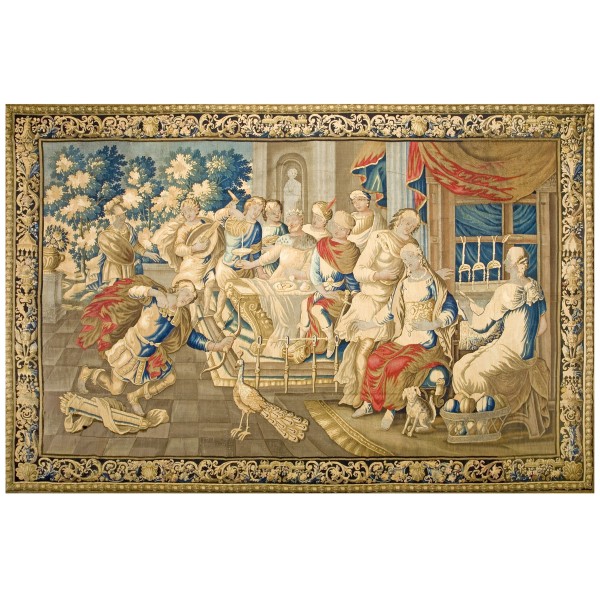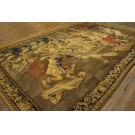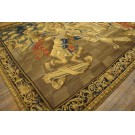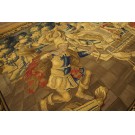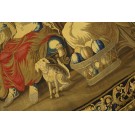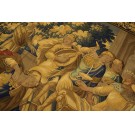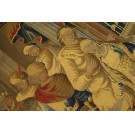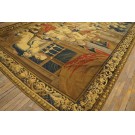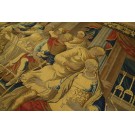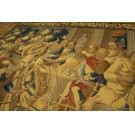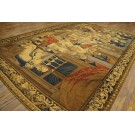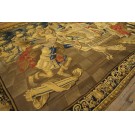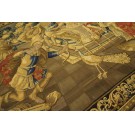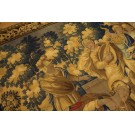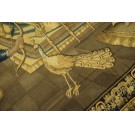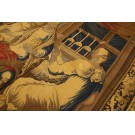Mid 17th Century Brussels Tapestry
Period: Circa 1650
Origin: Brussels? No mark
Workshop: Unknown
Structure:
Warp: wool, z-2-s, 13/in.
Weft: wool, z-2, average 56/in.
Iconography: Pastiche of mythological elements.
Foreground figures:
1. At left Odysseus (Ulysses) shooting an arrow through a ring target. Taken from the episode from the Odyssey where the suitors of Penelope (see below) try to bend Odysseus’ bow (only he can do it); he shoots an arrow through a target of axes in sequence in the megaron (big room in the palace). Odysseus is often shown bearded, as is this figure.
2. At right, Penelope (Odysseus’ wife) who has been awaiting his return for years. She has been weaving a tapestry, promising to select a suitor from the crowd of potential mates when she finishes weaving. But she unravels it at night, so she hopes Odysseus can return.
3. The dog in the foreground is a well known symbol of fidelity, Penelope’s fidelity for Odysseus.
All the other characters are taken from other mythological sources.
So we have:
4. Hera (Juno) The elaborately dressed woman to Penelope’s left. Her symbol the peacock appears in the foreground.
At the table are:
5. Zeus (Jupiter), crowned, the king of the gods of Olympus being served by:
6. Ganymede, the divine cupbearer;
7. Mars, at far left with sword, shield and helmet;
8. Possibly Hermes (Mercury) The divine messenger seated to the right of Jupiter with sword.
The other figures in exotic dress (Turbans; etc) are basically fillers in the composition.
The lute playing musician is at several removes taken from a 16th century Italian print.
Tapestries were usually made in sets and this, therefore ought to be part of larger ensemble. But what? A story of Odysseus? Examples of Fidelity? A search of the literature, admittedly not complete, does not turn up any other example en suite – sharing a similar border, for example, and style of drawing.
The only other tale from classical mythology involving a woman weaving, is that of Arachne who Athena (Minerva) turned into a spider for her presumption to weave as well as the goddess. But that has only a group of woman as onlookers, not a mixed crowd of gods. And there are no tapestries of that subject matter known.
There is another Penelope panel, in Boston, depicting her alone, at her loom. French or Flemish, circa 1480. It is much smaller (5’1” x 3’4”) and part of a wholly distinct series depicting Virtuous women. There is, of course, no stylistic connection.
The border seems to retain elements of Mannerist origin: winged heads, strap-work fragments, shells, baldachins, as well as later acanthine rinceaux. This lacks the later elaborate, realistic. Three dimension al rendition of fruits & flauers of the 17th century.
The workshop is probably not identifiable (lacking another example in the series with weaver’s signature or mark), although the border is somewhat distinctive. The somewhat schematic depiction of foliage implies a workshop outside of Brussels. The provincial character is also indicated, the non-symmetry of the long borders. The design center is to the left of the physical center. This would not have been acceptable in a more accomplished shop with higher quality control.
The pasticchio character of the scene also argues for a less sophisticated operation. Higher quality pieces are quite icon-graphically exact and there is usually no confusion as to the personages, events, etc. The quality is decorative, perhaps made for speculative sale rather than for a patron’s special order with exacting requirements. The buyer wanted a colorful mythological effect without troubling himself with the exact meaning of it all.
| Stock ID: | #18445 |
| General Rug Type: | European |
| Specific Rug Type: | Tapestry |
| Circa: | 1650 |
| Ground Color: | Multi |
| Border Color: | Black |
| Origin: | Belgium |
| Material: | Wool & Silk |
| Weave: | Flat Weave |
| Shape: | Rectangle |
| Width: | 10' 6" ( 320 cm ) |
| Length: | 15' 6" ( 472 cm ) |
DescriptionTapestryTechnically, any neff patered fabric in which the discontinuous wefts are separated by slits, or are joined by warp sharing or weft interlocking. In this broad sense, a tapestry could be Turkish (kilim), Chinese (silk Kesi), Peruvian, Navaho. Indian (Dhurrie),etc. More precisely as an art form it refers to European wall hangings made in that technique from court and commercial workshops from Flanders to France, Italy, Germany, England and Spain, from the 14th century onward. Pictorial subjects predominate in period pieces, but some are abstract armorials. Modern tapestry designs are often by major artists and are adapted from pre-existing paintings. Traditionally, the subjects have been narrative (mythological, historical, religious) on descriptions (landscapes). The subject is vast, the price range equally so, from decorative up to highly important period works of cut. Carpets are made in tapestry weave see Aubusson. Bessarabian entries. See also Tapestry- Flemish, French, Verdure. | |
| Tearsheet Download | |
